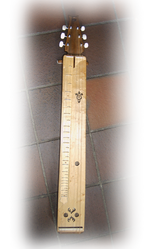Epinette des Vosges
 |
|
| String instrument | |
|---|---|
| Hornbostel–Sachs classification | 314.122 (Box zither) |
| Developed | 18th century |
| Related instruments | |
|
|
The épinette des Vosges is a traditional plucked-string instrument of the zither family, whose use was confined to two areas in the Vosges mountains of France approximately 50 km apart: around Val-d'Ajol and around Gérardmer.
The épinette has been attested as early as the 18th century in the Val-d'Ajol and Plombières-les-Bains regions of southern Vosges, whence comes its name. The earlier origins of the épinette des Vosges remain unknown, though some believe the instrument was introduced by the Swedes during the Thirty Years' War. It is, however, also possible that it is descended from the medieval psaltery.
Instruments of this family, formerly widespread throughout Europe, are now primarily found in Norway (the langeleik), Iceland (the langspil), Flanders (the hummel), Hungary, as well as France. A parallel instrument, the Appalachian dulcimer is found in rural mountain areas of the Eastern United States.
This instrument is first attested in accounts dated 1730. The primitive version with four strings evolved into a five-string model. The Val-d'Ajol épinette is of small size, between 50 and 60 cm, in the form of a parallelogram with a wide base. The frets, originally numbering fourteen, increased to seventeen in the 19th century. The fretting is diatonic, tuned to open C major. It is fretted with the fingers of the left hand, or alternately with a small piece of smooth wood. The right hand strums with the thumb, a goose quill, or a pick.
The most prolific épinette luthier was Amé Lambert (1843–1908), who manufactured up to 500 épinettes per year.
This instrument was first attested in 1723. It is a simple instrument built by luthiers, or by the musicians themselves. The instrument fell out of vogue, and little is known about it until it was revived after 1945.
...
Wikipedia
